Russian Tsar Simeon Bekbulatovich
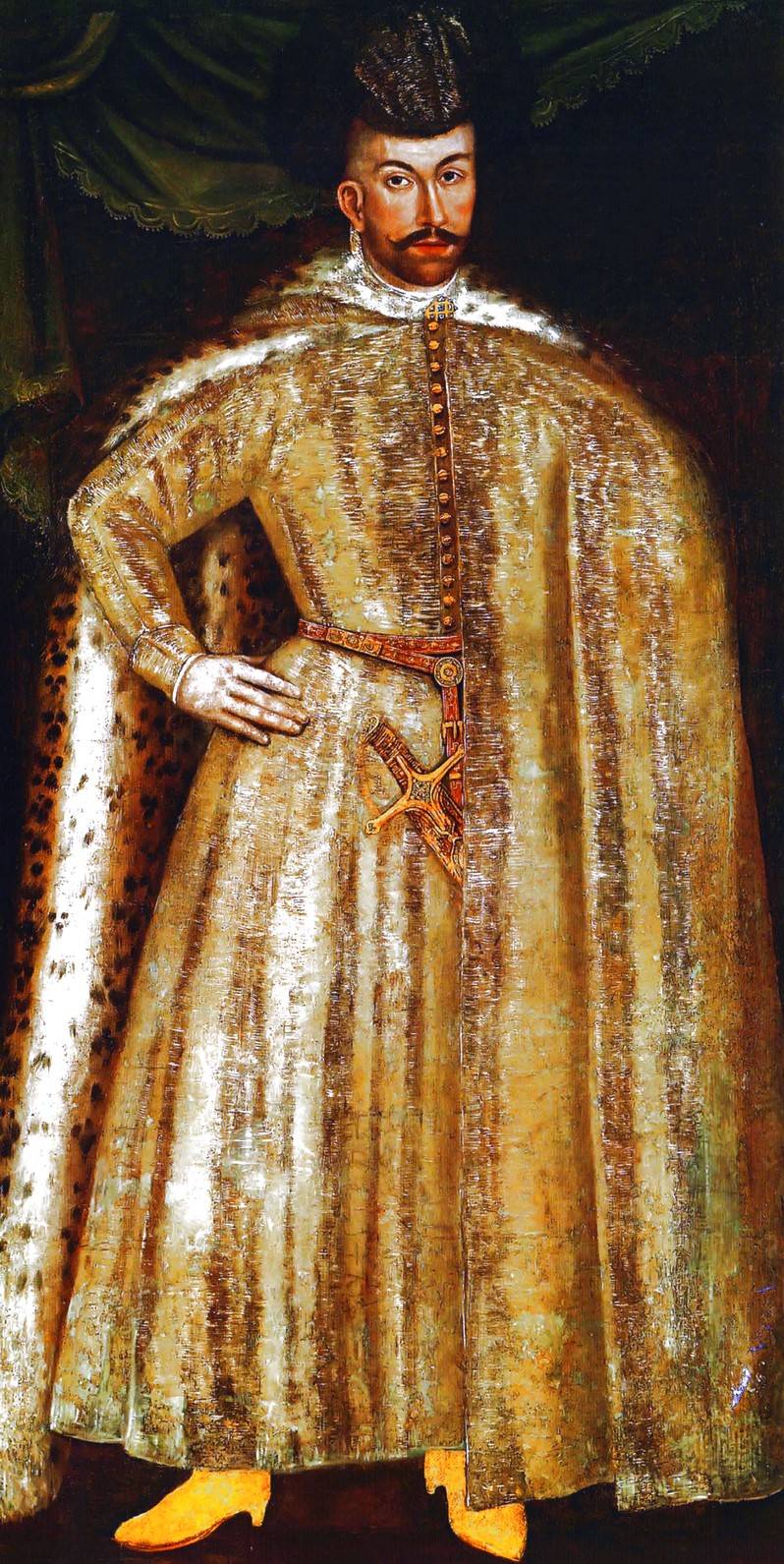
Simeon Bekbulatovich in a portrait by an unknown Polish artist, Nesvizh Castle, late XNUMXth – early XNUMXth centuries.
In Russian stories There are many mysteries, a clear answer to which has not yet been obtained. Two of them concern the reign of Ivan IV (the Terrible), and both are associated with the unexpected attempts of this tsar to “abdicate the throne.”
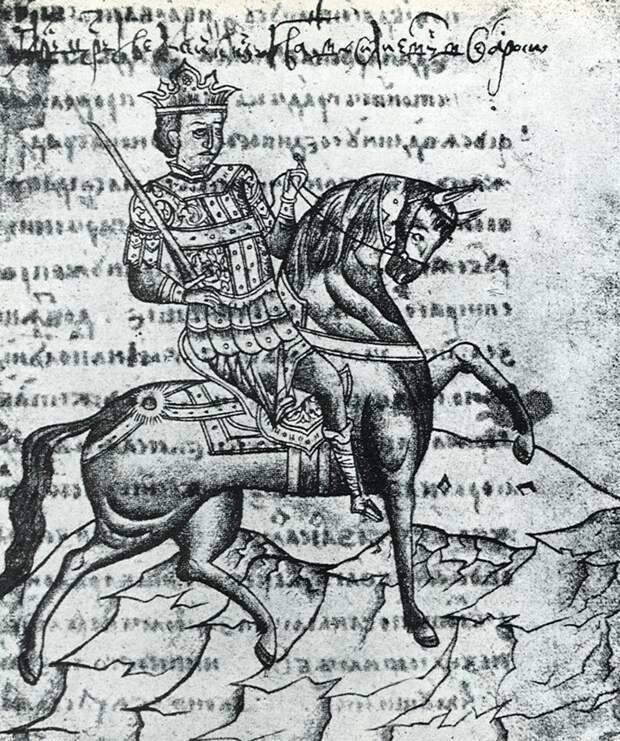
Ivan IV, miniature from the Kazan Chronicle
For the first time, he suddenly, without explanation, left Moscow on December 3, 1564 and, settling in Aleksandrovskaya Sloboda, sent two letters to the capital. In the first of them, he accused the boyars of numerous insults that they inflicted on him “due to his youth,” and the clergy of harboring “traitors.” In the second he stated that he was not offended by ordinary people in any way. The result, as you know, was the division of the state into two parts - Zemshchina and Oprichnina, and confirmation of the tsar’s right to punish “traitors” at his discretion.
And in the fall of 1575, Ivan Vasilyevich nevertheless “stepped down from the throne,” losing it to the baptized Tatar (Astrakhan) “prince,” Simeon Bekbulatovich, for 11 months. The former Kasimov Khan, the great-grandson of the Khan of the Great Horde Akhmat (known to everyone from the “Standing on the Ugra” in 1480) received the title of “Grand Duke of All Rus'”, and with him the Kremlin, the royal palace with servants, horse-drawn carriages for travel and all the required regalia . And Ivan IV became the appanage prince “Ivan of Moscow” and addressed the new tsar in full accordance with the etiquette of those years:

One of Ivan IV’s petitions to Simeon Bekbulatovich
By the way, in official addresses to the monarch, noble people then called themselves “slaves”, peasants and other ordinary people - “orphans”, and the title of “tsar’s servant” was considered higher than the boyar’s. Boris Godunov, for example, was the “royal servant” of his son-in-law (sister’s husband) – Fyodor Ioannovich.
Let's return to the hero of the article.
In the chronicle you can read:
A small clarification: Simeon was not officially crowned king. But during his short reign, he ordered the execution of several boyars and nobles. In addition, by his decrees many church lands were confiscated.
In today's article we will talk about the fate of this little-known Russian Tsar.
Origin of King Simeon
The father of the hero of the article, the Chingizid prince Bek-Bulat Sultan, was born into the family of the youngest son of the mentioned Khan Akhmat.
By the way, Akhmat’s grandchildren were also Khan Simeon Kasaevich, who defended Kazan from the troops of Ivan the Terrible, Alexander Sakhibgireevich from the Gireyev family, who was taken prisoner at the age of two in Kazan and baptized in Moscow, the grandfather of the wife of the hero of the article - Pyotr Ibrahimovich, the brother of the Kazan kings. All of them are considered representatives of the Greater Horde or Astrakhan dynasty.
Bek-Bulat Sultan lived in the Nogai Horde, where his relatives ruled. He was married to Altynchach, the elder sister of Ivan the Terrible’s second wife, Maria Temryukovna. In 1558 Bek-Bulat transferred to Russian service.
Before this, in 1555, the majority of the Nogais, led by Biy Ismail, came “under the arm” of Moscow. The other part of the Nogais went to Kuban, and Russian troops will fight with them under Catherine II.
Bek-Bulat took part in the war with Lithuania, went to Smolensk. He died in 1566, either from natural causes or from wounds received in a clash with the Lithuanians.
In 1567, his son Sain-Bulat became the ruler of the Moscow-dependent Kasimov Khanate, replacing the deceased king Shigaley (Shah-Ali Khan). He had no idea about his unprecedented rise and sad old age.
Kasimov Khan Sain-Bulat
So, the hero of the article is a descendant of the khans of the Great Horde, and therefore few people in Moscow were more noble than him. After all, the origin of the Chingizids was officially considered royal, and the Rurikovich and Gediminovich family was only considered princely. The Chingizids, who occupied some kind of throne for at least a few days (in Kazan, Astrakhan or Crimea), were called kings in Rus', others were called “saltans” or princes.
All the rulers of Kasimov before Sain-Bulat were princes; the first Kasimov king was the hero of our article, although he had not previously occupied any throne.
The Kasimov Khanate or kingdom, which was also called the Meshchersky yurt, is often spoken of as “Moscow’s gateway to the east.” Back in the middle of the XNUMXth century, Vasily II granted the Kazan princes Kasim and Yakub “to feed” Gorodets Meshchersky, which became known as the Tsarevich Town, and then the name Kasimov was assigned to it. Some believe that the allocation of land to these princes was one of the conditions for the release of Vasily II, who was captured by Khan Ulu-Muhammad. According to the chronicles, Dmitry Shemyaka, before blinding Vasily, whom he had captured, reproached him about this:
There is also information about the payment of “exit” to the Kasimov khans; the last records about it date back to the time of Ivan the Terrible, but the rulers of Kasimov had already established themselves in Moscow and swore allegiance to the Grand Duke (and then to the Russian tsars).
Probably, this “exit” was in the nature of payment for military service, because since the time of Ivan III, evidence has appeared in documents about the participation of Kasimov’s men in wars on the side of Moscow. Let us note, by the way, that the soldiers of the standing army of Kasimov’s rulers are called Cossacks in some documents. After the fall of Kazan, payments of “exit” to the “Kasimov princes” were completely stopped. In 1570, the Moscow ambassador I.P. Novosiltsov, in a conversation with the Turkish Sultan Selim, directly called the Kasimov Khan Sain-Bulat a “servant” of Ivan the Terrible:
The Kasimov Khanate also included the beyliks of Kadom, Temnikov, Shatsk, Enkai and others, which retained a certain independence. It was in Kasimov that the last ruler of the Kazan Khanate, Syuyumbike, settled in 1552. This kingdom was abolished only in 1681.
Kasimov Khanate on maps:
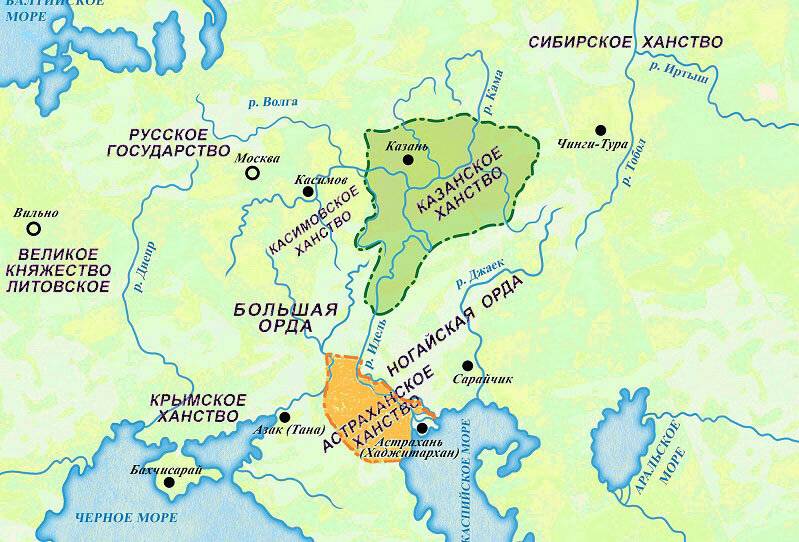
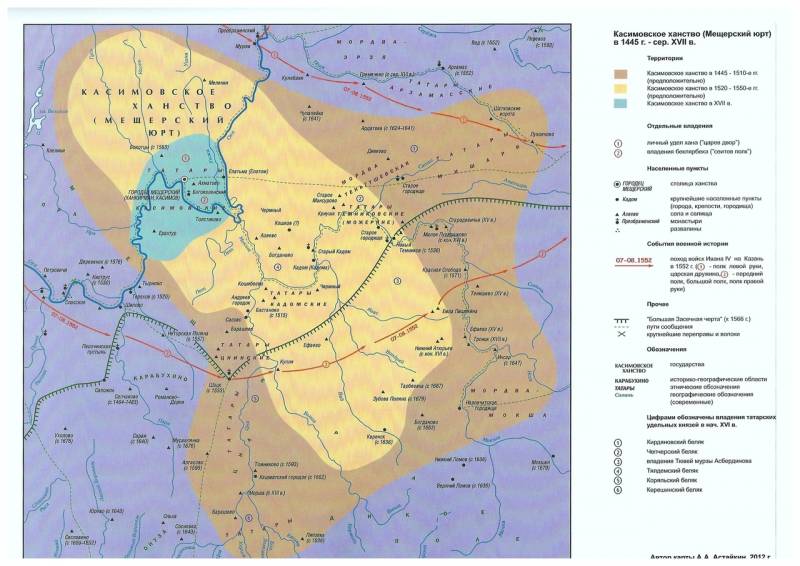
Kasimov's Tsar Sain-Bulat took part in the Livonian War, but did not achieve much success. On January 23, 1573, the troops of the Kasimov king and governor Ivan Fedorovich Mstislavsky (the future father-in-law of the hero of the article) were defeated in the battle with the Swedes near Kolovery (Lode).
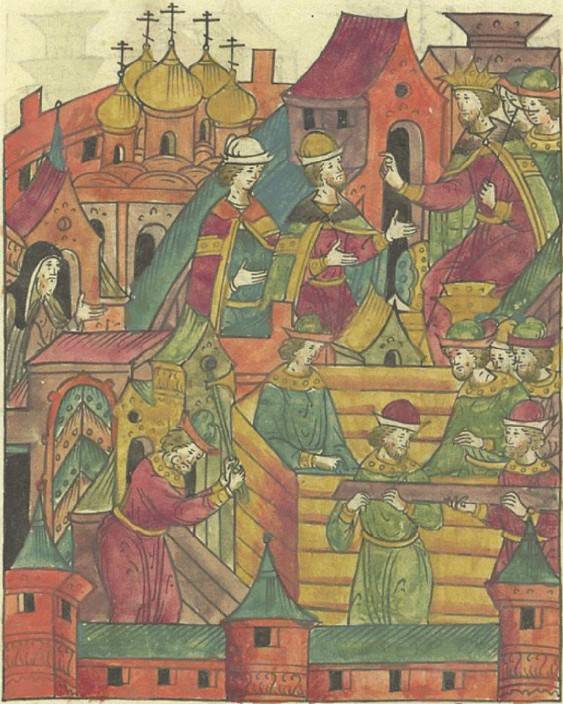
Ivan IV favors Prince Vladimir Andreevich and boyar Ivan Fedorovich Mstislavsky with chambers near the Trinity Court, miniature of the Front Chronicle. XVI century
Simeon Bekbulatovich
In 1573, Ivan the Terrible ordered the Kasimov Tsar Sain-Bulat to be baptized. He received the name Simeon, but continued to have the same patronymic - not Christian: Bekbulatovich.
And then the tsar married him to one of the most noble women of Moscow - Anastasia Miloslavskaya from the Gediminovich family, a relative of the Moscow Grand Dukes (granddaughter of the younger sister of Vasily III) and the Kazan khans, the widow of the Astrakhan prince Mikhail Kaibulovich (head of the boyar duma in 1572-1575), great-granddaughter of the khan Great Horde of Akhmat. This marriage turned out to be successful - the spouses loved each other.
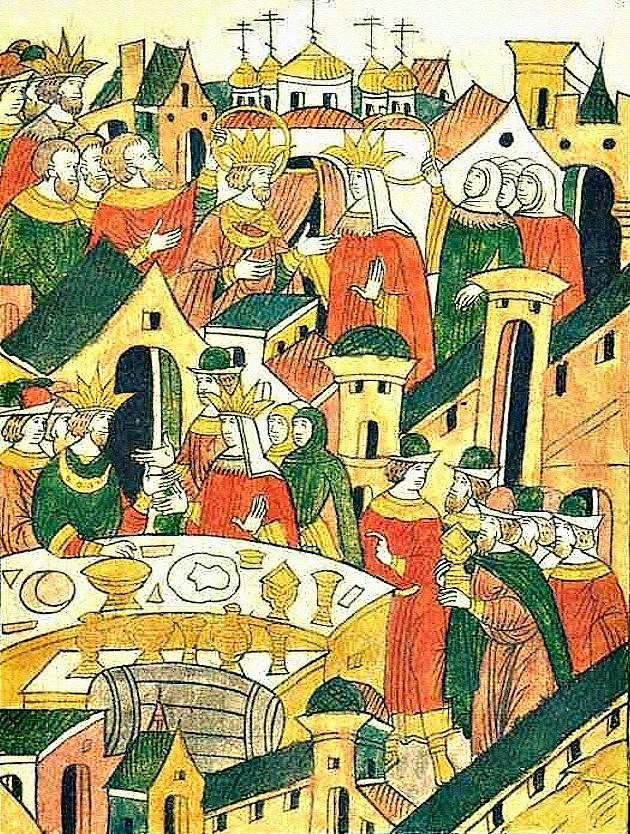
The wedding of Simeon Bekbulatovich and Anastasia Mstislavskaya in a miniature from the Front Chronicle. XVI century
Six children were born into this family, but none of them survived their father.
Since Kasimov's king could only be a Muslim, Simeon had to give up the throne to Mustafa Ali. And Mustafa’s successor, Uraz-Muhammad, was executed in Kaluga on the orders of False Dmitry II, which, as you remember, led to the death of this impostor.
The chronicle reports that the Nogai prince Peter (Araslan) Urusov, while hunting, shot False Dmitry with a pistol, and then, with the words: “I will teach you how to drown the khans and put the Murzas in prison,” cut off his head. He then moved to Astrakhan, where he found and supported a new “pretender” known as False Dmitry IV.
But let’s return to 1573 - and we are faced with another historical mystery: why did Ivan the Terrible force the completely loyal Sain-Bulat to be baptized and thereby “reduce” him from the Kasimov throne? By giving him, as compensation, the most honorable title of “royal servant,” which, besides him, was held only by the winner of the Crimean Khan in the Battle of Molodi, Prince Mikhail Vorotynsky.
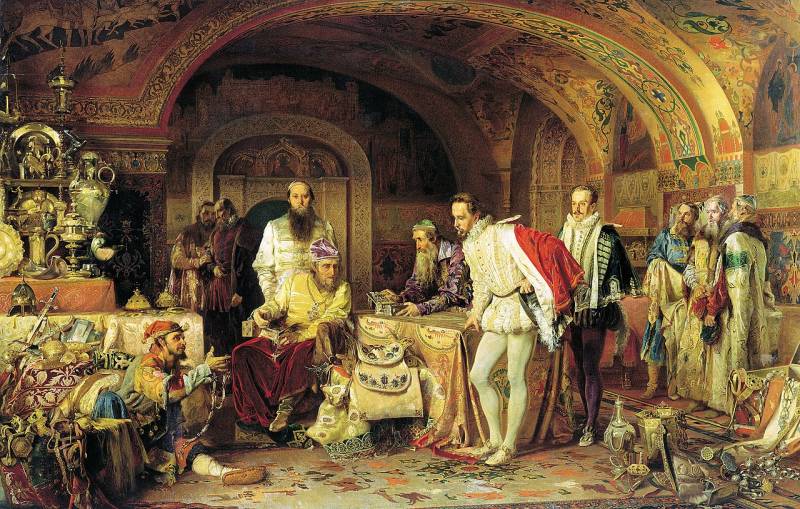
A. Litovchenko. “Ivan the Terrible Shows Treasures to the English Ambassador Horsey” (1875). We see Simeon Bekbulatovich standing behind the king
Perhaps even then, in 1573, Ivan IV was thinking through a combination of transferring his throne to Simeon Bekbulatovich for a short time?
Tsar Simeon
Contrary to popular belief, the enthronement of Simeon Bekbulatovich did not seem offensive to either the boyars or the common people. The boyars waged endless local disputes and were ready to consider the enthronement of any representative of competing families a loss of honor. However, everyone unconditionally recognized the primacy and royal dignity of the purebred Genghisid Simeon.
The only obstacle could be religion, however, as we remember, he converted to Orthodoxy two years ago. Baptized Chingizids traditionally occupied a very high position in Moscow. Ivan III in 1477, having gone on a campaign against Novgorod, left Tsarevich Murtaza as his governor in Moscow. And his son Vasily III in 1518, having learned about the approach of the Crimean Khan’s troops, left Moscow, entrusting its defense to the Tatar prince Peter.
Tatar origin in no way prevented the Astrakhan prince Mikhail Kaibulovich from 1572–1575. head the Zemstvo Duma.
But what were the reasons that prompted Ivan the Terrible in 1575 to go so far and make such an extravagant decision?
Versions
Quite often, they try to view the transfer of the throne to Simeon Bekbulatovich as a sophisticated mockery of the boyars who were forced to serve the Tatar. However, as we have already said, Genghisid and a direct descendant of the Great Horde Khan Akhmet, Simeon Bekbulatovich, was so superior in nobility to each of the boyars that serving him could in no way be shameful. However, according to one of the chronicles, there were those who declared to Ivan IV:
However, there were very few of them; in general, Simeon’s accession passed calmly and without incidents.
Some believe that Ivan the Terrible used Simeon Bekbulatovich to carry out a number of unpopular reforms that helped strengthen the financial position of the state. Large tracts of church land were confiscated, and many tarkhans were abolished—the so-called tax benefits granted to the monasteries by Ivan’s predecessors. The English diplomat Giles Fletcher wrote in his book “On the Russian State”:
Supporters of another version believe that in his destiny Ivan IV continued the fight against the opposition - and the “central” boyar Duma could no longer prevent him from doing this.
There is an interesting version according to which the reason for Ivan the Terrible’s temporary abdication of the throne was a prediction either from a visiting astrologer or from the Magi. According to this prophecy, the Moscow Tsar was sure to die within a year. The fact that there were such rumors is reported, for example, by the Piskarevsky chronicler. And such predictions were taken more than seriously in those days.
And therefore Ivan IV allegedly decided to “deceive fate.” He declared himself not a tsar, but a Moscow appanage prince, and gave Simeon the title of Grand Duke of All Rus'. Thus, it turns out that for 11 months the Tsar simply was not in Moscow. After the expiration of the specified period, Ivan again became the Tsar of Moscow, and gave Simeon the Great Reign of Tver.
Simeon was not an ambitious person, did not crave power, and therefore, apparently, he gave up the throne without the slightest resistance.
However, some believe that Ivan IV was then actually removed from power by the boyars and believe that Ivan the Terrible’s fears for his life were well founded. They explain his strengthening of distant Vologda and requests for asylum in England not by paranoia, but by a real and very serious danger, information about which was erased from the chronicles that have survived to our time.
Some historians, for example V. Klyuchevsky and S. Platonov, believed that Simeon Bekbulatovich was a purely decorative figure and the country continued to be ruled by Ivan, who “went into the shadows.” But others believe that a kind of division of power took place: Simeon dealt mainly with internal affairs, Ivan with external ones - that is, Ivan IV and Simeon Bekbklatovich can be called co-rulers.
Simeon Bekbulatovich after the death of Ivan the Terrible
In Tver, the former tsar initially had his own court and some attributes of power. He also had the right of trial on his territory. Simeon was not included in the regency council under the feeble-minded Tsar Fyodor Ioannovich, but it included the father-in-law of the former Tsar, Ivan Miloslavsky, who, however, was soon sent by Boris Godunov to “retire” to the Kirillo-Belozersky Monastery of the Vologda Diocese. Here he died - in 1586.
During the reign of Fyodor Ioannovich, Simeon Bekbulatovich lost his last title: he was mentioned for the final time as the Grand Duke of Tver in 1585. From Tver, together with his family, he was sent to the Kushalinsky volost, which belonged to him, to which, however, palace clerks were appointed.
When Boris Godunov was elected to the throne, a clause was included in the text of the oath obliging “Tsar Simeon Bekbulatovich and his children and others not to see anyone else in the Muscovite kingdom.” By that time Simeon was blind.
Some historians suggest that he could have been blinded on the orders of Boris Godunov, but it is unlikely that this king was such a big fan of the traditions of the long-defunct Byzantium. Simeon himself, according to Marzharet, complained that he had gone blind because Godunov allegedly sent him poisoned wine (a medieval surrogate based on methyl alcohol). But people in those days also went blind from natural causes, for example from cataracts, as well as from diabetes mellitus or high-grade arterial hypertension.
False Dmitry I, who entered Moscow, ordered Simeon to be sent to the Kirillo-Belozersky Monastery, allegedly because the former Muslim refused to support his plan to introduce Catholicism in Rus'. When he was tonsured, he received the name of Elder Stefan. His wife Anastasia, who became nun Alexandra, was also placed in the monastery.
Vasily Shuisky, who came to power after the murder of the Pretender, ordered the former tsar to be sent to Solovki. Only in 1612 did he achieve his return to the Kirillo-Belozersky Monastery, and in 1615 - to Moscow, where he soon died - on January 5, 1616. By that time, both his wife and children had already died.
At Simeon's request, he was buried next to his wife in the family cemetery of the Simonov Monastery. In 1930, many of the buildings of this monastery were demolished, and the grave of the only Russian Tsar, Genghisid, was lost.
Information